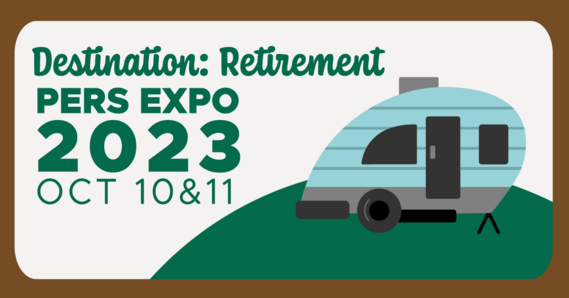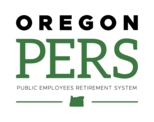|
DECEMBER 2023
 2023 virtual PERS Expo offers retirement guidance
More than 11,000 public employees registered for this year’s PERS Expo, learning more about their PERS benefits to help them prepare for a secure retirement.
Expo was again offered as an online-only event and provided members with live, interactive, and on-demand presentations and question-and-answer sessions.
Expo was launched in October, with live sessions presented October 10 and 11. If you were unable to attend in October, recordings and downloadable retirement resources are still available to explore online through December 31, 2023.
Expo’s offerings include:
- Checklists of key steps to take on your journey to retirement.
- Topical sessions about PERS and retirement planning.
- Options for extra retirement savings beyond PERS, including Oregon Savings Growth Plan (OSGP) and its advantages.
- Health insurance options offered to retirees by PERS Health Insurance Program.
- Various recorded presentations by PERS, OSGP, Social Security, and other partners.
|
|
2023 member annual statements to arrive in May
As year’s end approaches, you may wonder when you will receive your next member annual statement. Your 2023 statement will be mailed by the end of May 2024 and will reflect data submitted by your employer as of December 31, 2023.
It takes that long to prepare your statement for two reasons:
- The PERS Board must adopt final earnings crediting before statements can be finalized. This adoption will occur at the board's April 1, 2024, meeting.
- PERS must painstakingly check the accuracy of contribution information received from more than 900 employers regarding more than 180,000 nonretired member accounts.
While you wait, explore our Member Annual Statement FAQs webpage, which includes interactive examples and information to help you understand your statement. Also, check that your mailing address, phone number, and email address are correct through your Online Member Services (OMS) account. If you need to change your information, contact your employer to have it updated in the PERS reporting system. If you are not currently working for a PERS-participating employer, you can change your information yourself in OMS. Make any necessary changes as soon as possible.
To receive alerts about annual statements, sign up for GovDelivery emails on this topic from PERS. If you have questions, contact Member Services.
|
|
One-time variable transfer deadline is December 31
|
Do you have a variable account you want to permanently transfer into your regular account beginning January 1, 2024? If yes, then PERS must receive a completed One-Time Variable Transfer form from you no later than December 31, 2023. Read the form and our One-Time Variable Account Transfer webpage for eligibility requirements and more information.
|
|
|
 |
|
|
 Got a COLA? Use it to build a secure retirement
Are you a state employee receiving a cost-of-living adjustment (COLA) as the result of recent union-bargaining efforts? Have you thought about how you might use the increase to bolster your retirement savings?
Here’s one option: You could invest your COLA on a pretax basis with a voluntary retirement tool like the Oregon Savings Growth Plan (OSGP).
And here’s how it might work: If your COLA amounted to a $100 increase in salary, you may only get $70 to $80 after taxes if you took the money home today. But if you instead contributed that $100 to a pretax investment option, all of that $100 would be saved for you and have the opportunity to grow with time — helping you to create a more secure retirement.
And it’s not just state employees who can do this.
OSGP is available to any Oregon-based public employee whose employer participates in the plan.
And it doesn’t have to be just a COLA that you invest. OSGP is available any time you want to save a little extra money for retirement.
Why is it important to save more for retirement with plans like OSGP? Because it could help you bridge any gaps you might have between the income you’ll receive from your pension, Individual Account Program (IAP), and Social Security in retirement.
Read more about OSGP and bridging the gap on PERS’ Oregon Savings Growth Plan webpage, or check out the resources OSGP has waiting for you on the OSGP website.
|
|

Thank you to the more than 7,700 members who took our 2023 member satisfaction survey earlier this year.
Your feedback will be used to help improve our services and how we assist you.
A presentation of survey results is available in the PERS Board’s September meeting packet online. The survey presentation begins on page 46 of the packet.
You also can check out a recording of the full board meeting online.
|
|
|
Find salary limit information on the PERS website

At PERS, a member's “subject salary” is used to determine their Individual Account Program (IAP) contributions, employer contributions to fund the pension program, and the final average salary for calculating retirement benefits under formula methods. In 2020, Senate Bill (SB) 1049 began changing limits on subject salaries. The limits can vary each year based on the Consumer Price Index.
For more details about SB 1049, read the Senate Bill 1049 (2019) — Member Information webpage.
|
|
|
Keep your beneficiary designations up to date

Naming your beneficiaries and keeping those designations current is a critical part of retirement planning.
Here’s why: If you have not designated a beneficiary prior to your death, PERS will pay the balance of your member account in a priority order set by state law. Effective January 1, 2024, that order is:
- A surviving spouse or someone required by law to be treated as a spouse.
- Surviving children.
- Your estate.
Locating next of kin can be challenging and substantially delay payment of your benefits to your survivors. To avoid delays, PERS encourages members to complete and submit beneficiary forms for both your pension and your Individual Account Program (IAP) account. Submit beneficiary forms directly to PERS; turning them into your employer doesn't count.
If you have designated a beneficiary and die before retirement, PERS will pay the amounts in your Tier One or Tier Two member account and your IAP account to your designated beneficiary.
If your death meets certain criteria, your employer may pay your beneficiary an additional amount that matches the value of your Tier One or Tier Two member account.
If your spouse is your sole Tier One or Tier Two beneficiary, they may receive the Optional Spouse Death Benefit (OSDB), which is a lifetime monthly payment based on your salary and service credit, if certain conditions are met:
- You are working for a PERS-participating employer at the time of your death, or your death is within 120 days after your employment ended.
- Your spouse is named as your preretirement death beneficiary.
- Survivors immediately notify PERS about your death.
- Your spouse completes an OSDB estimate/election form that PERS sends them. Effective January 1, 2024, PERS must receive the form from your spouse within 60 days of the date on the estimate. Postmarks do not count.
When a survivor or executor notifies PERS of your death, PERS will ask them to provide the date of death, city and state where the death occurred, a photocopy of the death certificate, and their contact information.
Processing death benefits typically can take months. To avoid processing delays, PERS recommends keeping your beneficiary designations current. Again, your survivors or executors should notify PERS of your death as soon as possible.
If you have questions about beneficiaries, contact PERS. Beyond the death of a member, you will want to contact PERS when other major life events occur, such as marriage, divorce, or the death of a beneficiary.
|
|
|

By Heather Case
PERS Senior Policy Advisor
Working with the Oregon Legislature is an ongoing process for PERS, the agency.
The Legislature meets each year in one of two types of sessions:
- Short session — Is 35 days long and occurs in even-numbered years.
- Long session — Is 160 days long and occurs in odd-numbered years.
This year’s session, which adjourned in June, was a long one, and PERS' staff members followed it the whole way to keep tabs on bills that could impact your retirement plans.
Besides tracking bills, PERS' staff also provided information and testimony to legislative committees about how certain bills could affect the agency's operations.
In the end, lawmakers passed multiple bills that the agency will work to implement in the coming months.
One such bill is House Bill (HB) 2296. This bill extends the rules for working after retirement that were originally set by Senate Bill (SB) 1049 in 2019. SB 1049 removed limits on the number of hours a retiree could work for a PERS-participating employer in a calendar year after retirement. HB 2296 extends the removal of limits until 2034. These rules, however, do not apply to early retirees or disability retirees.
Meanwhile under HB 2296, employers will pay contributions for retirees who work after retirement. These contributions will not go directly to the retirees’ account because they are already retired. Instead, the employer contributions will help pay down PERS’ unfunded actuarial liability, or UAL. In plain language, UALs occur when a pension system’s bills (e.g., benefits they pay or anticipate paying to current and future retirees) exceed its income (e.g., contributions coming into the plan from members and employers).
Under the rules of HB 2296, retirees are able to receive both their monthly retirement benefit payments and a paycheck from working, and the PERS plan receives additional contributions.
Read more about HB 2296 and other bills impacting PERS from the 2023 legislative session on our Enacted 2023 PERS legislation webpage.
The work for PERS doesn’t end with the legislative session. Once the Legislature adjourns, state agencies must work to implement all new laws to ensure we are in compliance on or before they go into effect.
For PERS, most of the legislation impacting the agency will go into effect on January 1, 2024, which will keep agency staff busy this fall and winter as we work to get the bills impacting PERS implemented.
Our implementation process usually begins with our policy team, who interprets what the bill says and what it directs the agency to do. That team meets with other departments to ensure that agency staff understands and can follow all requirements of the new bill. For example, this may involve updating information on forms you fill out as a member, how we process the forms you submit, and how Member Services answers your inquiries.
And while we work on implementing bills from the 2023 legislative session, agency staff also must look ahead at what’s coming next. That includes looking as far ahead as the 2025 long session. State agencies can request the Governor’s Office to introduce bills on behalf of the agency but only during those long sessions.
As PERS, the agency, plans for the 2025 legislative session, we will work with PERS members and employers regarding issues to take to the Legislature. We will present potential legislative ideas to the PERS Board during their April 2024 board meeting.
|
|
|

If you are about to retire and reviewing your health insurance options, visit the PERS Health Insurance Program (PHIP) website. The website offers information about PHIP eligibility rules; Medicare, non-Medicare, and dental plans; PHIP rates; and answers to other health insurance questions.
Contact PHIP at 1-800-768-7377 or visit the PHIP website for more information.
|
|
|
PERS benefit payments support Oregon’s economy

Oregon PERS paid about $4.6 billion in benefits to retired members or their beneficiaries living in Oregon in 2022. The $4.6 billion figure does not include payments from the Individual Account Program (IAP).
PERS conducts an annual economic impact study to show how benefits paid to PERS' retirees support the state’s economy. Funding for PERS retirement benefits comes mostly from investment earnings on contributions previously paid by PERS members and public employers.
The financial impact of PERS benefits is not limited to $4.6 billion. Benefit payments also generate tax revenue and support jobs and related wages.
When adjusted to include tax revenue, jobs and wages, the value of PERS retirement payments to Oregon’s economy grows to $4.89 billion.
Read the full Economic Impact Study 2022 online.
|
|
|

Are you planning to retire in the near future? Don’t wait until the last minute to prepare.
Check out these helpful resources from PERS to get ready:
Also, keep the following important points in mind:
- Retirement applications must be submitted to PERS within 90 days of your retirement day.
- It can take up to 92 days from your retirement date (not the date of your application submission) for your first pension benefit to be paid.
- Once PERS receives your application, we will review your account information and reconcile data with your employer(s) as needed. Data discrepancies can sometimes cause your finalized benefit amount to differ from benefit estimates you received earlier. Remember that benefit estimates are just that — estimates.
- Filling out your application correctly, checking your personal information in OMS or on your member annual statement, requesting benefit estimates, and responding to requests from PERS for additional information can help you avoid delays in the processing of your application. If you are working for a PERS-participating employer and find errors in your personal/account information, contact your employer for corrections. If you are not working for a PERS-participating employer, read the inactive member section on our Change your address webpage for instructions.
-
Individual Account Program (IAP) retirement benefits can typically take from 90 to 120 days to process and complete payments or rollovers. Processing is done both by PERS and Voya, which administers IAPs for PERS.
- If you are purchasing time, contact PERS to make sure the check you mailed was received.
If you have questions, contact Member Services for assistance.
|
|
|
 |
|
You can get alerts on topics that include:
- Member news
- PERS Health Insurance Program
- Legislation affecting members
- PERS Board meetings
- PERS administrative rulemaking
|
|
|
|
Mailing address:
PERS
PO Box 23700
Tigard, OR 97281-3700
Physical address:
11410 SW 68th Parkway Tigard, OR 97223
Phone: 888-320-7377
TTY: 503-603-7766
Phone lines open 8:30 a.m. to 5 p.m. Monday through Friday, except holidays.
|
|
We serve the people of Oregon by administering public employee benefit trusts to pay the right person the right benefit at the right time.
Chair: Sadhana Shenoy
Vice Chair: Stephen Buckley
Members: Jardon Jaramillo, John Scanlan, and Suzanne Linneen
Director: Kevin Olineck
Deputy Director: Yvette Elledge-Rhodes
Chief Financial Officer: Richard Horsford
Chief Information Officer: Jordan Masanga
Chief Compliance, Audit, and Risk Officer: Jason Stanley Chief Operations Officer: Sam Paris
For more information contact:
PERS | PHIP | OSGP
|
|
|
Perspectives is published by the Oregon Public Employees Retirement System for the benefit of members and employers. It is emailed three times a year.
|
|
|
|
|